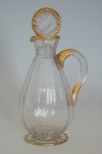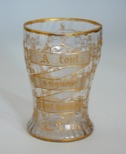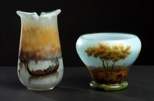A practical guide to Emile Galle, Daum-Nancy and Charles Schneider.Including right or wrong, lessons in glass. |
A practical guide to Daum glassThe history of the Daum factory starts in 1878 with Jean Daum buying an old glass factory in need for his two sons. This factory produced tableware, drinking glasses and decanters in clear glass with gilding. First period. Drinking glasses and art glass with historic influences. 1878-1895. Gradually the line of product of this factory changes into art glass. First they procuce drinking glasses with gilding. So mouth blown glass and then handpainted with gold. When you buy such a glass , the gold must be still fresh and visible. No two pieces are identical. |
 |
Then their drinking glasses become little pieces of art. Some of the glasses are wheelcarved by hand. Some are acid-etched and some have a combination of these three techniques, gilding, carving and acid-etching. Most of the glass is clear glass, but after a while they start to use light green, light pink and light brown. The subjects on the glass can be flowers of the region or historic themes linked to national feelings of Lorrain. Such as the French rooster or the thistle or a fleur de lis. Sometimes these pictures are accompanied with a text. In this case , we name the glass: “verrerie parlante”. In English this means: “talking glass”. One that I personally like enormously ,is the one with the poison ivy: “Je meurs ou je m’attache”.I find this so romantic. Another example is: Qui s’y frotte, s’y pique.” This text is accompanied with the thistle. When you touch a thistle , it will hurt. Really these vases refer to the French-German war in 1870. The French want to say: “Germany do not touch us, you will get hurt.”
The world exposition in1889 influenced the Daum brothers enormously. Antonin and Auguste Daum were impressed by the work of the great art nouveau artist Emile Galle. This was the beginning of a new era.
The art nouveau period by Daum. 1895-1914
Cameo glass and pate de verre.
The Daum brothers decided to start their own art department. With the help of Jacques Gruber and Henri Berge and Almaric Walter ,they designed vases and lamps and chandeliers and art objects.
Many of these objects were made as art objects, not to be used. That is why many of these objects have survived a century, because they were displayed in cabinets as objects of value. They were extremely expensive at the beginning of the 20th century and still are a hundred years later.
In these years you can encounter a few different techniques.
To be continued in september !!!!!!
 |
 |
 |
 |
 |
 |
 |
 |
 |
 |
 |
 |
 |

